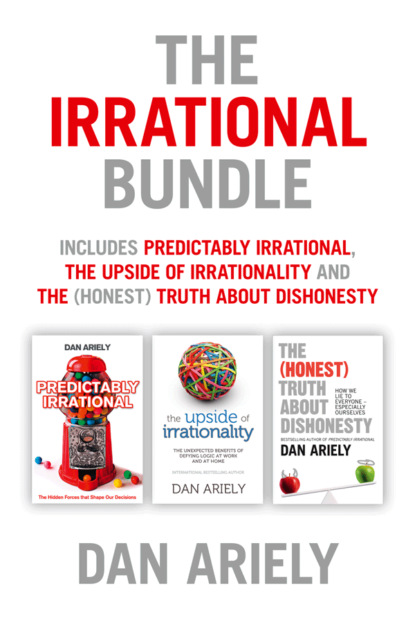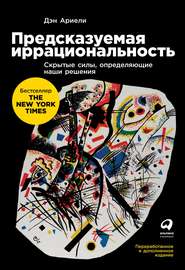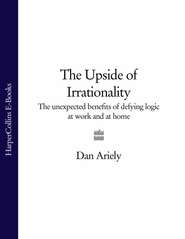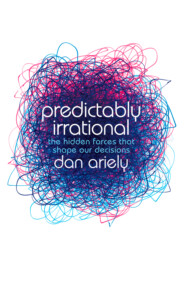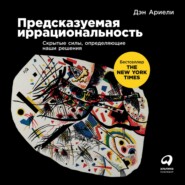По всем вопросам обращайтесь на: info@litportal.ru
(©) 2003-2024.
✖
The Irrational Bundle
Автор
Год написания книги
2018
Настройки чтения
Размер шрифта
Высота строк
Поля
My most recent personal encounter with this involved a car. When I was looking for a new car a few years ago, I knew that I really should buy a minivan. In fact, I had read up on Honda minivans and knew all about them. But then an Audi caught my eye, at first through an appealing offer—FREE! oil changes for the next three years. How could I resist?
To be perfectly honest, the Audi was sporty and red, and I was still resisting the idea of being a mature and responsible father to two young kids. It wasn’t as if the free oil change completely swayed me, but its influence on me was, from a rational perspective, unjustifiably large. Just because it was FREE! it served as an additional allure that I could cling to.
So I bought the Audi—and the FREE! oil. (A few months later, while I was driving on a highway, the transmission broke—but that is a different story.) Of course, with a cooler head I might have made a more rational calculation. I drive about 7,000 miles a year; the oil needs to be changed every 10,000 miles; and the cost per change is about $75. Over three years, then, I would save about $150, or about 0.5 percent of the purchase price of the car—not a good reason to base my decision on. It gets worse, though: now I have an Audi that is packed to the ceiling with action figures, a stroller, a bike, and other kids’ paraphernalia. Oh, for a minivan.
THE CONCEPT OF zero also applies to time. Time spent on one activity, after all, is time taken away from another. So if we spend 45 minutes in a line waiting for our turn to get a FREE! taste of ice cream, or if we spend half an hour filling out a long form for a tiny rebate, there is something else that we are not doing with our time.
My favorite personal example is free-entrance day at a museum. Despite the fact that most museums are not very expensive, I find it much more appealing to satisfy my desire for art when the price is zero. Of course I am not alone in this desire. So on these days I usually find that the museum is overcrowded, the line is long, it is hard to see anything, and fighting the crowds around the museum and in the cafeteria is unpleasant. Do I realize that it is a mistake to go to a museum when it is free? You bet I do—but I go nevertheless.
ZERO MAY ALSO affect food purchases. Food manufacturers have to convey all kinds of information on the side of the box. They have to tell us about the calories, fat content, fiber, etc. Is it possible that the same attraction we have to zero price could also apply to zero calories, zero trans fats, zero carbs, etc.? If the same general rules apply, Pepsi will sell more cans if the label says “zero calories” than if it says “one calorie.”
Suppose you are at a bar, enjoying a conversation with some friends. With one brand you get a calorie-free beer, and with another you get a three-calorie beer. Which brand will make you feel that you are drinking a really light beer? Even though the difference between the two beers is negligible, the zero-calorie beer will increase the feeling that you’re doing the right thing, healthwise. You might even feel so good that you go ahead and order a plate of fries.
SO YOU CAN maintain the status quo with a 20-cent fee (as in the case of Amazon’s shipping in France), or you can start a stampede by offering something FREE! Think how powerful that idea is! Zero is not just another discount. Zero is a different place. The difference between two cents and one cent is small. But the difference between one cent and zero is huge!
If you are in business, and understand that, you can do some marvelous things. Want to draw a crowd? Make something FREE! Want to sell more products? Make part of the purchase FREE!
Similarly, we can use FREE! to drive social policy. Want people to drive electric cars? Don’t just lower the registration and inspection fees—eliminate them, so that you have created FREE! In the same way, if health is your concern, focus on early detection as a way to eliminate the progression of severe illnesses. Want people to do the right thing—in terms of getting regular colonoscopies, mammograms, cholesterol checks, diabetes checks, and such? Don’t just decrease the cost (by decreasing the co-pay). Make these critical procedures FREE!
I don’t think most policy strategists realize that FREE! is an ace in their hand, let alone know how to play it. It’s certainly counterintuitive, in these times of budget cutbacks, to make something FREE! But when we stop to think about it, FREE! can have a great deal of power, and it makes a lot of sense.
Reflections on the Price of FREE!
We learned from our experiments that we all get a bit too excited when something is FREE! and that consequently, we can make decisions that are not in our best interest.
For example, imagine that you were choosing between two credit cards: one that offers you a 12 percent APR but has no yearly fee (FREE!), and one that offers you a lower interest rate of 9 percent APR but charges you a $100 annual fee. Which one would you take? Most people would overemphasize the yearly fee and in pursuit of the FREE! offer would end up getting the card that costs them much more in the long run—when they inevitably miss a payment or carry a balance.* (#litres_trial_promo)
Although identifying and fighting the allure of FREE! is important in order to avoid traps while we are making decisions, there are also some cases in which we can use FREE! to our advantage. Take, for example, the common experience of going to a restaurant with friends. When the server drops off the check at the end of a meal, people often scramble to figure out the norms for payment. Do we each pay for what we ordered? Do we split the bill evenly, even if John had that extra glass of wine and the crème brûlée? FREE! can help us solve this problem, and in the process help us get more joy from dining out with our friends.
The answer, as it turns out, is that one person should pay the entire bill, and that the people involved should take turns paying over time. Here is the logic: When we pay—regardless of the amount of money—we feel some psychological pain, which social scientists call the “pain of paying.” This is the unpleasantness associated with giving up our hard-earned cash, regardless of the circumstances. It turns out that the pain of paying has two interesting features. First, and most obviously, when we pay nothing (for example, when someone else foots the bill) we don’t feel any pain of paying. Second, and less obviously, the pain of paying is relatively insensitive to the amount that we pay. This means that we feel more pain of paying as the bill increases, but every additional dollar on the bill pains us less. (We call this “diminishing sensitivity.” Analogously, if you add one pound to an empty backpack, it feels like a substantial increase in weight. But adding a pound to a backpack that’s already laden with a laptop and some books does not feel like a big difference.) This diminishing sensitivity to the pain of paying means that the first dollar we pay will cause us the highest pain, the second dollar will cause us less, and so on, until we feel just a tiny twinge for, say, the forty-seventh dollar.
So if we are dining with others, we are happiest when we pay nothing (FREE!); we are less happy when we have to pay something; and the additional dollars we fork over cause us a smaller and smaller additional amount of pain as the size of the bill increases. The logical conclusion is that one person should pay the whole bill.
If you’re still unconvinced, consider the following example: Imagine that four people share a meal and the bill comes to $100. Now, if everyone at the table pays $25, every person would feel some pain of paying. In order to make this less abstract, let’s assign “units” as a measure of this pain. We’ll assume that paying $25 translates into 10 units of pain for a total of 40 units of pain for the whole table when it comes time to split the bill. But what if one person pays the entire bill? Since the pain of paying does not increase linearly with the amount of payment, the person who is paying will feel 10 units of pain for the first $25 that he or she pays; maybe 7 units for the next $25; 5 units for the next $25; and 4 units for the last $25. The total of 26 units of pain lowers the amount of pain for the entire table by 14 units. The general point is this: we all love getting our meals for nothing, and as long as we can alternate payers, we can enjoy many FREE! dinners and derive greater overall benefit from our friendships in the process.
“Aha,” you might say, “but what about times when I eat only a green salad while my friend’s husband orders a green salad, a filet mignon dinner, two glasses of the most expensive cabernet sauvignon, and a crème brûlée for dessert? Or when the number of people changes the next time we gather? Or when some people in the group leave town altogether? All of this leaves me holding the bag.”
Certainly, there is no question that all these considerations make the “I’ll buy this time, you buy next time” approach less economically efficient. Nevertheless, given the huge benefits in terms of the pain of paying that this method delivers, I personally would be willing to sacrifice a few bucks here and there to reduce the pain of paying for my friends and myself.
Appendix: Chapter 3
Let me explain how the logic of standard economic theory would apply to our setting. When a person can select one and only one of two chocolates, he needs to consider not the absolute value of each chocolate but its relative value—what he gets and what he gives up. As a first step the rational consumer needs to compute the relative net benefits of the two chocolates (the value of the expected taste minus the cost), and make a decision based on which chocolate has the larger net benefit. How would this look when the cost of the Lindt truffle was 15 cents and the cost of the Hershey’s Kiss was one cent? The rational consumer would estimate the amount of pleasure he expects to get from the truffle and the Kiss (let’s say this is 50 pleasure units and five pleasure units, respectively) and subtract the displeasure he would get from paying 15 cents and one cent (let’s say this is 15 displeasure units and one displeasure unit, respectively). This would give him a total expected pleasure of 35 pleasure units (50 – 15) for the truffle, and a total expected pleasure of four pleasure units (5 - 1) for the Kiss. The truffle leads by 31 points, so it’s an easy choice—the truffle wins hands down.
What about the case when the cost is reduced by the same amount for both products? (Truffles cost 14 cents and the Kiss is free.) The same logic applies. The taste of the chocolates has not changed, so the rational consumer would estimate the pleasure to be 50 and five pleasure units, respectively. What has changed is the displeasure. In this setting the rational consumer would have a lower level of displeasure for both chocolates because the prices have been reduced by one cent (and one displeasure unit). Here is the main point: because both products were discounted by the same amount, their relative difference would be unchanged. The total expected pleasure for the truffle would now be 36 pleasure units (50 - 14), and the total expected pleasure for the Kiss would now be five pleasure units (5 - 0). The truffle leads by the same 31 points, so it should be the same easy choice. The truffle wins hands down.
This is how the pattern of choice should look, if the only forces at play were those of a rational cost-benefit analysis. The fact that the results from our experiments are so different tells us loud and clear that something else is going on, and that the price of zero plays a unique role in our decisions.
CHAPTER 4
The Cost of Social Norms
Why We Are Happy to Do Things, but Not
When We Are Paid to Do Them
You are at your mother-in-law’s house for Thanksgiving dinner, and what a sumptuous spread she has put on the table for you! The turkey is roasted to a golden brown; the stuffing is homemade and exactly the way you like it. Your kids are delighted: the sweet potatoes are crowned with marshmallows. And your wife is flattered: her favorite recipe for pumpkin pie has been chosen for dessert.
The festivities continue into the late afternoon. You loosen your belt and sip a glass of wine. Gazing fondly across the table at your mother-in-law, you rise to your feet and pull out your wallet. “Mom, for all the love you’ve put into this, how much do I owe you?” you say sincerely. As silence descends on the gathering, you wave a handful of bills. “Do you think three hundred dollars will do it? No, wait, I should give you four hundred!”
This is not a picture that Norman Rockwell would have painted. A glass of wine falls over; your mother-in-law stands up red-faced; your sister-in-law shoots you an angry look; and your niece bursts into tears. Next year’s Thanksgiving celebration, it seems, may be a frozen dinner in front of the television set.
WHAT’S GOING ON here? Why does an offer for direct payment put such a damper on the party? As Margaret Clark, Judson Mills, and Alan Fiske suggested a long time ago, the answer is that we live simultaneously in two different worlds—one where social norms prevail, and the other where market norms make the rules. The social norms include the friendly requests that people make of one another. Could you help me move this couch? Could you help me change this tire? Social norms are wrapped up in our social nature and our need for community. They are usually warm and fuzzy. Instant paybacks are not required: you may help move your neighbor’s couch, but this doesn’t mean he has to come right over and move yours. It’s like opening a door for someone: it provides pleasure for both of you, and reciprocity is not immediately required.
The second world, the one governed by market norms, is very different. There’s nothing warm and fuzzy about it. The exchanges are sharp-edged: wages, prices, rents, interest, and costs-and-benefits. Such market relationships are not necessarily evil or mean—in fact, they also include self-reliance, inventiveness, and individualism—but they do imply comparable benefits and prompt payments. When you are in the domain of market norms, you get what you pay for—that’s just the way it is.
When we keep social norms and market norms on their separate paths, life hums along pretty well. Take sex, for instance. We may have it free in the social context, where it is, we hope, warm and emotionally nourishing. But there’s also market sex, sex that is on demand and that costs money. This seems pretty straightforward. We don’t have husbands (or wives) coming home asking for a $50 trick; nor do we have prostitutes hoping for everlasting love.
When social and market norms collide, trouble sets in. Take sex again. A guy takes a girl out for dinner and a movie, and he pays the bills. They go out again, and he pays the bills once more. They go out a third time, and he’s still springing for the meal and the entertainment. At this point, he’s hoping for at least a passionate kiss at the front door. His wallet is getting perilously thin, but worse is what’s going on in his head: he’s having trouble reconciling the social norm (courtship) with the market norm (money for sex). On the fourth date he casually mentions how much this romance is costing him. Now he’s crossed the line. Violation! She calls him a beast and storms off. He should have known that one can’t mix social and market norms—especially in this case—without implying that the lady is a tramp. He should also have remembered the immortal words of Woody Allen: “The most expensive sex is free sex.”
A FEW YEARS ago, James Heyman (a professor at the University of St. Thomas) and I decided to explore the effects of social and market norms. Simulating the Thanksgiving incident would have been wonderful, but considering the damage we might have done to our participants’ family relationships, we chose something more mundane. In fact, it was one of the most boring tasks we could find (there is a tradition in social science of using very boring tasks).
In this experiment, a circle was presented on the left side of a computer screen and a box was presented on the right. The task was to drag the circle, using the computer mouse, onto the square. Once the circle was successfully dragged to the square, it disappeared from the screen and a new circle appeared at the starting point. We asked the participants to drag as many circles as they could, and we measured how many circles they dragged within five minutes. This was our measure of their labor output—the effort that they would put into this task.
How could this setup shed light on social and market exchanges? Some of the participants received five dollars for participating in the short experiment. They were given the money as they walked into the lab; and they were told that at the end of the five minutes, the computer would alert them that the task was done, at which point they were to leave the lab. Because we paid them for their efforts, we expected them to apply market norms to this situation and act accordingly.
Participants in a second group were presented with the same basic instructions and task; but for them the reward was much lower (50 cents in one experiment and 10 cents in the other). Again we expected the participants to apply market norms to this situation and act accordingly.
Finally, we had a third group, to whom we introduced the tasks as a social request. We didn’t offer the participants in this group anything concrete in return for their effort; nor did we mention money. It was merely a favor that we asked of them. We expected these participants to apply social norms to the situation and act accordingly.
How hard did the different groups work? In line with the ethos of market norms, those who received five dollars dragged on average 159 circles, and those who received 50 cents dragged on average 101 circles. As expected, more money caused our participants to be more motivated and work harder (by about 50 percent).
What about the condition with no money? Did these participants work less than the ones who got the low monetary payment—or, in the absence of money, did they apply social norms to the situation and work harder? The results showed that on average they dragged 168 circles, much more than those who were paid 50 cents, and just slightly more than those who were paid five dollars. In other words, our participants worked harder under the nonmonetary social norms than for the almighty buck (OK, 50 cents).
Perhaps we should have anticipated this. There are many examples to show that people will work more for a cause than for cash. A few years ago, for instance, the AARP asked some lawyers if they would offer less expensive services to needy retirees, at something like $30 an hour. The lawyers said no. Then the program manager from AARP had a brilliant idea: he asked the lawyers if they would offer free services to needy retirees. Overwhelmingly, the lawyers said yes.
What was going on here? How could zero dollars be more attractive than $30? When money was mentioned, the lawyers used market norms and found the offer lacking, relative to their market salary. When no money was mentioned they used social norms and were willing to volunteer their time. Why didn’t they just accept the $30, thinking of themselves as volunteers who received $30? Because once market norms enter our considerations, the social norms depart.
A similar lesson was learned by Nachum Sicherman, an economics professor at Columbia, who was taking martial arts lessons in Japan. The sensei (the master teacher) was not charging the group for the training. The students, feeling that this was unfair, approached the master one day and suggested that they pay him for his time and effort. Setting down his bamboo shinai, the master calmly replied that if he charged them, they would not be able to afford him.
IN THE PREVIOUS experiment, then, those who got paid 50 cents didn’t say to themselves, “Good for me; I get to do this favor for these researchers, and I am getting some money out of this,” and continue to work harder than those who were paid nothing. Instead they switched themselves over to the market norms, decided that 50 cents wasn’t much, and worked halfheartedly. In other words, when the market norms entered the lab, the social norms were pushed out.
But what would happen if we replaced the payments with a gift? Surely your mother-in-law would accept a good bottle of wine at dinner. Or how about a housewarming present (such as an eco-friendly plant) for a friend? Are gifts methods of exchange that keep us within the social exchange norms? Would participants receiving such gifts switch out of the social norms and into market norms, or would offering gifts as rewards maintain the participants in the social world?
To find out just where gifts fall on the line between social and market norms, James and I decided on a new experiment. This time, we didn’t offer our participants money for dragging circles across a computer screen; we offered them gifts instead. We replaced the 50-cent reward with a Snickers bar (worth about 50 cents), and the five-dollar incentive with a box of Godiva chocolates (worth about five dollars).
The participants came to the lab, got their reward, worked as much as they liked, and left. Then we looked at the results. As it turned out, all three experimental groups worked about equally hard during the task, regardless of whether they got a small Snickers bar (these participants dragged on average 162 circles), the Godiva chocolates (these participants dragged on average 169 circles), or nothing at all (these participants dragged on average 168 circles). The conclusion: no one is offended by a small gift, because even small gifts keep us in the social exchange world and away from market norms.
BUT WHAT WOULD HAPPEN if we mixed the signals for the two types of norms? What would happen if we blended the market norm with the social norm? In other words, if we said that we would give them a “50-cent Snickers bar” or a “five-dollar box of Godiva chocolates,” what would the participants do? Would a “50-cent Snickers bar” make our participants work as hard as a “Snickers bar” made them work; or would it make them work halfheartedly, as the 50-cents made them work? Or would it be somewhere in the middle? The next experiment tested these ideas.





